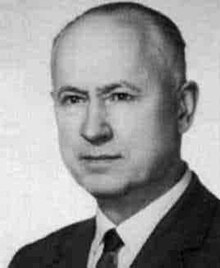|
Karol Borsuk
Karol Borsuk (8 May 1905 – 24 January 1982) was a Polish mathematician. His main area of interest was topology. He made significant contributions to shape theory, a term which he coined. He also obtained important results in functional analysis. He was a professor of mathematics at the University of Warsaw, a member of the Polish Academy of Sciences, the Polish Mathematical Society and a leading representative of the Warsaw School of Mathematics. Life and careerEarly life and educationBorsuk was born in 1905 in Warsaw to father Marian, a surgeon, and mother Zofia (née Maciejewska). In 1923, he graduated from the Stanisław Staszic State Gymnasium in Warsaw.[1] Between 1923–1927, he studied mathematics at the Faculty of Philosophy of the University of Warsaw. He received his master's degree and doctorate from Warsaw University in 1927 and 1930, respectively. His PhD thesis title was On the Subject of Topological Characterization of Euclidean Spheres and his advisor was Stefan Mazurkiewicz. From 1929 to 1934, he worked at the Faculty of Mathematics at the University of Warsaw. He became a professor in 1938. In the interwar period, Borsuk visited Lwów, which was a thriving center of mathematics of the Second Polish Republic, and began his collaboration with Stanisław Ulam, especially in the field of topology. Borsuk joined the mathematicians in the Scottish Café and contributed to the open problems which they wrote down in the famous book.[2] World War IIDuring World War II, he run a stationary store and provided a secret meeting place for the Home Army. He designed and published a number of board games including Animal Husbandry, which enjoyed great popularity and was re-released in 1997 as Superfarmer.[3] In the years 1939–1944, he gave secret lectures at the University of Warsaw. In 1943, he was arrested for his participation in the resistance movement and spent a couple of months at the Pawiak Prison.[4] During the Warsaw Uprising in 1944, he was transported alongside his family to the Dulag 121 Camp in Pruszków. He managed to escape from the camp and remained in hiding until the end of the war.[5] Later careerIn 1945, he completed a project in collaboration with Bronisław Knaster and Kazimierz Kuratowski concerning the establishment of the Institute of Mathematics of the Polish Academy of Sciences.[6] In 1946, he returned to the University of Warsaw where he served as the Head of the Institute of Mathematics from 1952 to 1964. In 1952, he became a member of the Polish Academy of Sciences, and in 1953, a corresponding member of the Bulgarian Academy of Sciences. He was also a member of the Polish Mathematical Society. He worked as an editor-in-chief of Dissertationes Mathematicae and deputy editor-in-chief of Fundamenta Mathematicae. In 1946–47, he lectured at the Institute for Advanced Study at Princeton University, in 1959–60 at the University of California at Berkeley, in 1963–64 at the University of Wisconsin at Madison, and in 1967–68 at Rutgers University–New Brunswick.[5] In 1954, he received the Officer's Cross of the Order of Polonia Restituta for his "outstanding contributions to science".[7] In 1976, he was awarded an honorary doctorate by the University of Zagreb.[8] Borsuk's students include: Samuel Eilenberg, Andrzej Kirkor, Jan Jaworowski, Andrzej Granas, Antoni Kosiński, Karol Sieklucki, Włodzimierz Holsztyński, Rafał Molski, Hanna Patkowska, Andrzej Jankowski, Włodzimierz Kuperberg, Stanisław Spież, Krystyna Kuperberg, Jerzy Dydak, Andrzej Trybulec, Marian Orłowski, Alfred Surzycki.[9] Research Borsuk introduced the theory of absolute retracts (ARs) and absolute neighborhood retracts (ANRs), and the cohomotopy groups, later called Borsuk–Spanier cohomotopy groups. He also founded shape theory. He has constructed various beautiful examples of topological spaces, e.g. an acyclic, 3-dimensional continuum which admits a fixed point free homeomorphism onto itself; also 2-dimensional, contractible polyhedra which have no free edge. His topological and geometric conjectures and themes stimulated research for more than half a century; in particular, his open problems stimulated the infinite-dimensional topology. Some of the notable mathematical concepts that bear Borsuk's name include Borsuk's conjecture, Borsuk–Ulam theorem and Bing–Borsuk conjecture. Private lifeIn 1936, he married Zofia Paczkowska.[2] One of his two daughters, Magdalena, who was a Professor of Paleontology, was married to Polish mathematician Andrzej Białynicki-Birula.[10] He died in Warsaw in 1982 and was buried at the Powązki Cemetery.[11] In 2008, a commemorative plaque in honour of Borsuk was unveiled at the entrance to the tenement house in Warsaw at Filtrowa 63 Street where the mathematician used to live.[12] Works
See alsoReferences
External linksWikimedia Commons has media related to Karol Borsuk (mathematician). |
||||||||||||||||||||||
